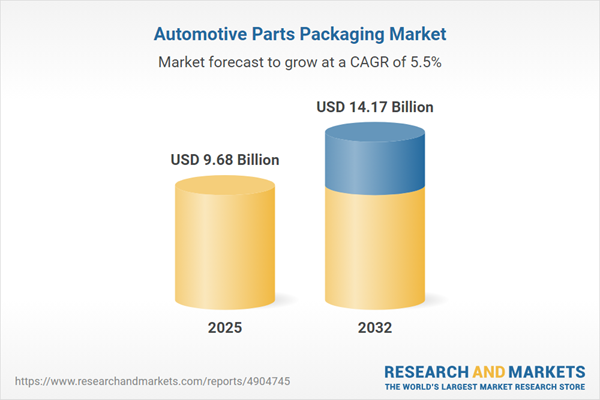Speak directly to the analyst to clarify any post sales queries you may have.
Automotive supply chains are increasingly complex, requiring senior decision-makers to prioritize reliable packaging strategies that support both global manufacturing continuity and compliance with evolving industry standards. Effective automotive parts packaging enhances operational stability, minimizes risk of disruption, and meets stringent logistics requirements for modern manufacturers and suppliers.
Market Snapshot: Automotive Parts Packaging Market Overview
The automotive parts packaging market experienced steady growth in 2024, achieving a market value of USD 9.20 billion, and is set to reach USD 9.68 billion in 2025. Market analysts project a compound annual growth rate of 5.53% through 2032, resulting in a valuation of USD 14.17 billion by the end of the period. This progression is driven by consistently strong vehicle production worldwide and new regulatory requirements influencing supply chain compliance. Regional industry leaders across North America, Latin America, Europe, the Middle East, Africa, and Asia-Pacific are implementing solutions tailored to their market landscapes. These approaches balance logistics efficiency and regulatory adherence, allowing secure movement of parts across continents.
Scope & Segmentation of the Automotive Parts Packaging Market
The current scope and segmentation within the automotive parts packaging market highlight several opportunities for alignment with organizational objectives and regulatory guidelines:
- Packaging Types: Disposable, reusable, and custom formats support flexible supply chain cycles while promoting process efficiency and cost control.
- Product Types: Commonly used packages include bags, sacks, blister packs, clamshells, corrugated boxes, crates, foam inserts, pallets, trays, tubes, and reels, each engineered to shield components in storage and transit.
- Material Types: Foam, aluminium, steel, paper, cardboard, various plastics (PE, PET, PP, PVC), textiles, and wood are selected based on durability, compliance, and cost management requirements.
- Component Applications: Protective solutions are deployed for electronics, batteries, engine parts, lighting elements, filters, underbody items, and cooling systems to prevent damage during shipping cycles.
- Application Functions: Anti-corrosion measures, electrostatic discharge (ESD) protection, impact resistance, and thermal regulation technologies preserve product quality and functionality throughout shipment processes.
- End Users: Scalable packaging is adopted by both automotive OEMs and aftermarket providers, addressing unique logistics demands and fostering rapid operational realignment.
- Regional Coverage: Packaging approaches vary to accommodate local regulations, logistical challenges, and market drivers on a global scale.
- Key Companies: Leading market participants—such as Corplex, Greif Inc., International Paper Company, Knauf Group, Mil-Spec Packaging of GA Inc., Mondi plc, Nefab AB, Packaging Corporation of America, Sealed Air Corporation, The Royal Group, Veritiv Corporation, and WestRock Company—shape industry direction and standards.
Key Takeaways for Senior Decision-Makers
- Flexible, modular packaging strategies ensure adaptive responses to fluctuating volumes and evolving supply chain models, elevating operational agility.
- Sustainable, recyclable packaging supports compliance with regulatory shifts while meeting stakeholder priorities for responsible sourcing and production.
- Highly protective packaging reduces risk to sensitive automotive parts, streamlining handling and optimizing storage management within multi-tier logistics operations.
- Advanced tracking and traceability technologies enhance oversight, fortifying supply chain transparency from manufacturing to product installation.
- Regional supply chain emphases differ widely, with the Americas leveraging renewable resources, Europe focusing heavily on regulation-driven packaging, and Asia-Pacific leading in tracking technology deployment.
- Coordination among procurement, logistics, and engineering is critical to ensuring the consistent rollout of high-quality, dependable packaging solutions across diverse segments.
Tariff Impact on Automotive Parts Packaging
Adjustments to U.S. tariffs have prompted manufacturers to increasingly favor local and nearshore sourcing options for packaging. These choices help reduce exposure to sudden cost changes and improve resilience against market fluctuations.
Methodology & Data Sources
This market analysis uses direct interviews with industry executives and frontline specialists, complemented by a thorough review of secondary datasets. Findings undergo a rigorous, multi-step triangulation and validation process to provide senior leaders with reliable and actionable insights.
Why This Report Matters
- Enables organizations to refine packaging strategies, supporting regulatory compliance, sustainability goals, and consistent operational performance across supply chains.
- Identifies emerging challenges and market opportunities, building organizational resilience and strengthening adaptability for future disruptions.
- Equips leaders with data-driven insights to underpin scenario planning and informed decision-making tailored to the complexities of automotive logistics.
Conclusion
Robust packaging approaches are fundamental for safeguarding the integrity and efficiency of global automotive supply chains. This research delivers the insights needed for sustained operational excellence and a structured competitive edge.
Additional Product Information:
- Purchase of this report includes 1 year online access with quarterly updates.
- This report can be updated on request. Please contact our Customer Experience team using the Ask a Question widget on our website.
Table of Contents
3. Executive Summary
4. Market Overview
7. Cumulative Impact of Artificial Intelligence 2025
Companies Mentioned
The companies profiled in this Automotive Parts Packaging market report include:- Corplex
- Greif, Inc.
- Griff Paper & Film
- Holostik
- International Paper Company
- Knauf Group
- Mil-Spec Packaging of GA, Inc.
- Mondi PLC
- Nefab AB
- Orlando Products
- Pacific Packaging Products, Inc.
- Packaging Corporation of America
- Peoria Production Solutions, Inc.
- PM PACKAGING
- Pratt Industries, Inc.
- Primex Plastics Corp. by ICC Industries Inc.
- Sealed Air Corporation
- Specialised Packaging Group
- Stephen Gould
- Storopack Hans Reichenecker GmbH
- The Royal Group
- The Smurfit Kappa Group PLC
- Veritiv Corporation
- WestRock Company
- Wisconsin Foam Products
Table Information
| Report Attribute | Details |
|---|---|
| No. of Pages | 183 |
| Published | November 2025 |
| Forecast Period | 2025 - 2032 |
| Estimated Market Value ( USD | $ 9.68 Billion |
| Forecasted Market Value ( USD | $ 14.17 Billion |
| Compound Annual Growth Rate | 5.5% |
| Regions Covered | Global |
| No. of Companies Mentioned | 26 |









